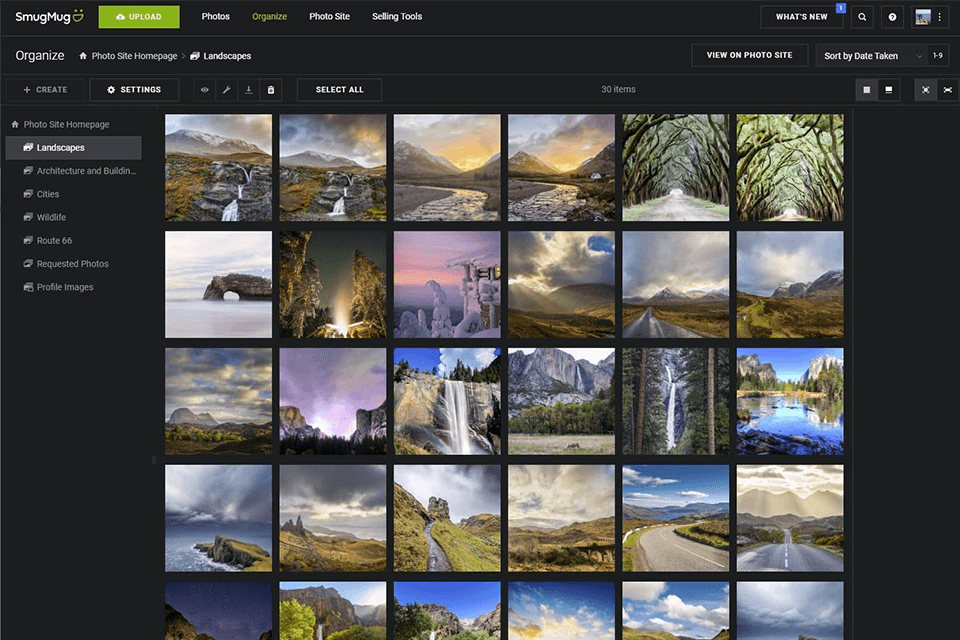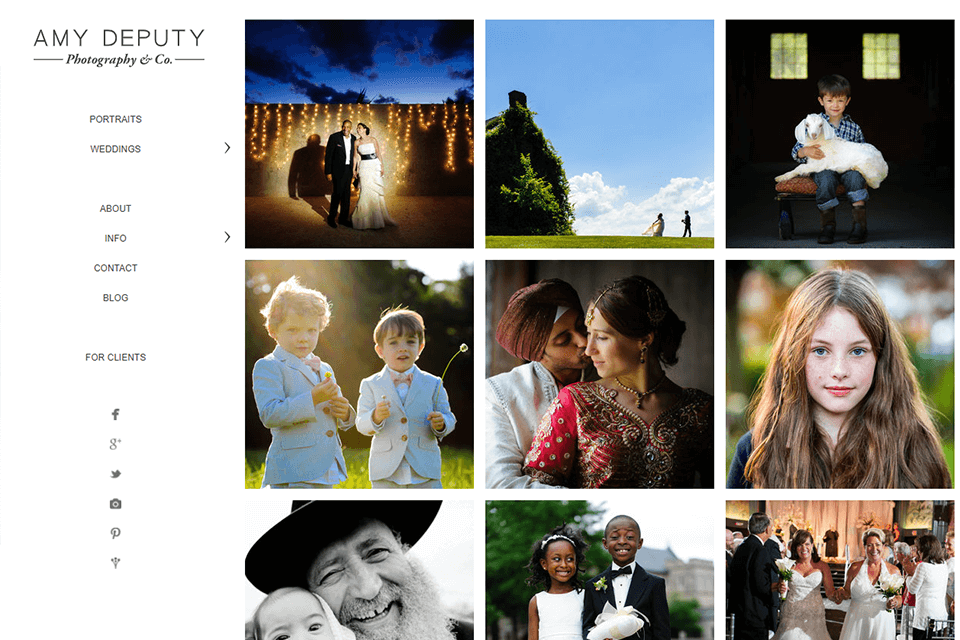
If you are a professional photographer, you need to create a portfolio of your works to engage new clients and improve your online presence. Poor-quality photos might affect your sales and discourage potential customers from ordering your services. In this article, I will tell you how you can create a pro-level photography portfolio and develop your business brand.
It might be difficult to select the best photos and nicely organize them unless you have a modern website with a well-thought-out layout. Read on to learn how to build a professional portfolio from scratch.
While the process of creating a portfolio might seem too difficult at first, you will quickly build your website if you follow these simple steps. In this article, you will find 15 tips that will come in handy for everyone who is wondering how to create a portfolio and expand their client base.

To find new clients, you can build a photography website, use social media platforms for posting your photos, or print your best works and use them as promo materials. Each option has its advantages and shortcomings. Portfolio websites are quite affordable and allow you to improve your online presence.
You can easily customize, share links to your works, and update your photographer portfolio with new pictures. There are many useful website builders for photographers that will help you to create an easy-to-navigate portfolio. You can use them even without any coding skills.
If you want to find the best software for creating your site, take a look at Adobe Portfolio and SmugMug. They will help you quickly build a website and customize it to your liking.

Even if you like experimenting and can boast of achievements in several photo styles, don’t cram your photography portfolio with too many shots from wedding and portrait photography, to landscape, newborn or any other photo session. Keep it simple and consistent.
Define the genre of images you will add to your portfolio. Otherwise, clients may get confused and treat you as an amateurish photographer who is still trying to figure what photography genre to work with. It will always make marketing to future clients much easier.

Beginner photographers often fail to organize their photos when creating a portfolio. If your site has a convoluted interface, make sure to group your pictures by theme or organize them by other parameters.
You can group your images by:
For instance, you can group photos by their color tint or create a series of photos that have a similar color palette.
Even professional photographers might need to enhance their photos so that they have a similar style. Keep in mind that building a photography portfolio is not an easy task if you don’t have pro-level photo enhancement skills. Nobody will pay attention to your portfolio if you upload poorly improved photos with bleak colors and visible flaws.
Since professional photo enhancement is difficult and time-consuming, it’s might be impossible for a beginner to improve their photos so that they meet the industry standards. Save your time and effort by contacting our service. We will quickly send you professionally upgraded photos for an affordable price. Our professionals can also easily match your signature style.

When you start developing your business, it’s important to use a logo that your potential clients can identify with. To make it more eye-catching, make sure to learn how to make a photography logo. Photography logos for your portfolio should be something that immediately catches attention, and is memorable.
You can use logo maker apps, as well as free logo makers, and 3D text and logo makers to create your unique logo. Many photographers use such elements of a logo as a camera shape or a diaphragm. While it’s the easiest way to show your potential clients what services you provide, there are so many logos like this that it might be impossible to create a unique one.

There is no need to post hundreds of photos on your website since it will load slowly and nobody will look through all of them. It’s better to select at least 15-20 photos for each category. For instance, if you take wedding photos, make sure there are enough images in the corresponding section.
It will help your clients to understand whether they like your style. If you specialize in product photography and don’t have any subcategories on your website, it might be a good idea to upload more photos. While selecting pictures for your art portfolio book, be very critical about each shot.
Ask yourself: “What would I think about this photographer if I saw such an image in his/her portfolio?” If you have any doubts about the quality of the image, its style and fit to the general theme – don’t include it in the portfolio.

Some photographers disregard this moment, but it’s important to make your brand’s name more noticeable. Your clients should see who they are dealing with. Make sure to create a personal brand with a consistent style.
This way, it will be easier for your customers to identify your photos with your brand when they see them online. Besides, it shows that you are a professional photographer. Don’t cover it with decorative elements.
It should be written in a clearly legible photography fonts, catch attention and be easy to remember.

When creating a photography portfolio, don’t forget to add the About page to tell your potential clients about yourself. It’s better to keep your introduction short and include a list of your clients. Most people also add their contact information.
It’s better to add links to all your social networks pages to make it easier to find you. Make sure to add your email and phone number as well.
Since your clients might be using different messengers and platforms, it’s better to include as much relevant information as possible. Besides, you need to add a link to your photography price list.

It’s never a good idea to upload large files on your website. Keep in mind that you can optimize the size of your photos without compromising their quality. Try resizing them with the help of the best image optimizers to reduce the load time of your website. If the images on your site load longer than 1 second, you might lose your potential clients.
Nobody is going to wait until your photos load even if they are of high quality. Besides, if you upload large photos, someone might steal them. The file size should be no bigger than 200MB. You can reduce the quality of your photos to 65%-85% and reduce their DPI to under 300.

Show your photos to experienced photographers whose works you like and to photographers that specialize in other areas to get their feedback. It will help you improve your shooting skills.
It’s better to get feedback from several photographers with extensive experience. You will get constructive critique and understand what problems you can fix. Besides, it will help you see your strongest points that make you different from other photographers.

If you don’t know what kind of photography portfolio you want to create and what images to upload, think about how you can grab the attention of your target audience. Look through other photographers’ portfolios and use them for inspiration.
Make sure to analyze the portfolios of other local photographers and create a site that will make you stand out. You need to select the right number of photos and find convenient templates. Besides, you can use innovative tools to make portfolios that immediately grab attention. For instance, with Smiler, photographers can effortlessly create a personalized storefront to showcase their portfolio, receive booking requests, and automatically collect and display testimonials.

Even if you create an amazing website with a well-thought-out interface, you need to ensure that your potential clients will find it. Make sure to use SEO software to improve keyword optimization.
The best SEO strategies update regularly so you need to use the newest optimization techniques. Learn how to use backlinks correctly and add relevant alt-text to describe portfolio pictures. Besides, you need to optimize the size of images to improve the load time.

Every photographer has been developing their signature style for years. This is why it’s important to keep your portfolio updated so that your clients can see your recent photos. For instance, you can update it every month, quarter, or year.
Some photographers update their portfolios even more often. If your portfolio is not updated regularly, your clients might think that your services aren’t in high demand or that you work only with a limited set of topics.

If you want to find paying customers, make sure to use Pinterest and similar platforms that allow people to share your portfolio photos. Besides, it will make it easier for users to bookmark them and later find them easily. Make sure to check whether social sharing is enabled on your website.
This way, your clients will be able to share your images on Pinterest, Facebook, and other networks. It will allow you to improve your online visibility and make it more convenient for users to find your website whenever they need it.

If you want to expand your client base, share your posts, stories, and photos on various social media platforms, such as TikTok, Pinterest, and Facebook. It’s one of the most effective photography marketing strategies for those who want to improve their online presence. Make sure to regularly update your pages and post high-quality content to engage your followers. It will help you get new clients.
If you add links to your social media pages to your portfolio, it will help you get new followers. You can try using Instagram marketing tools for rapid growth that will help you find your target audience and analyze what steps you need to take to expand your client base.
For instance, you can analyze your audience’s demographics and find out what posts are the most effective. Besides, you need to create a business page on Facebook since it will allow you to use various integrated tools to promote your brand and reach out to your clients.
The best way to understand what kind of website you need is to analyze the portfolios of other professional photographers and think about what makes them so successful. On this list, you will find the best photography portfolio examples that will help you build your own website.

Ryan has a minimalist portfolio with a simple, neat interface. All the photos are nicely organized, and the design looks quite eye-catching. There is no need to use many colors, add various sliders, or many tabs to make your portfolio more convenient to use.
It’s better to carefully select typography elements and make your website easy to navigate. This way, you can attract new customers.

Ara has a pretty basic website, but here you will find all the information you might need. The portfolio is nicely organized. There are several categories sorted by different wedding photography styles.
Here, you can also see a price list, blog, the About page, and testimonials. Since the website is so easy to navigate, you will quickly find everything that you need to know. Besides, the portfolio itself is easy to browse.

If you specialize in wedding photography and want to create an eye-catching portfolio that will help you expand your client base, take a look at this unusual website. You can use it as a reference when creating your portfolio.
Here, you will see the price list on the homepage. It allows potential customers to get all the necessary information about the available packages right away. Besides, you will see many beautiful examples of wedding photos here as well.

This is the so-called “blog-folio.” It means that the users show their portfolio photography in the blog posts in the form of stories. It may seem difficult to understand some blog-folios, but Kartsie’s website succeeds in solving this problem thanks to the lovely thumbnails.

While some photographers avoid using a horizontal layout when creating a portfolio, it can still look perfect if a website has a convenient navigation system. Caitlin’s website is easy to use and navigate. There is no need to enlarge images since you can see all of them even without using a full-screen mode.

If you need to create a custom portfolio, take a look at this website. Anchor & Lace have a website with an intuitive layout. Each page looks unique while still matching the overall design.
In the Stories section, you will find examples of wedding stories with beautiful illustrations. They are divided into chapters so that you can read them like a real book. It’s a perfect example of professional visual storytelling.

This professional photography portfolio loads quickly and has a great design. Thanks to its convenient layout, it’s easy to navigate. The design looks pretty neat despite many elements. On every page, you will find useful information, such as testimonials, galleries, and contact info. Here, the photographer also shares his personal thoughts on a variety of topics.

On The Crawleys’ site, you will find plenty of photos and informative blog posts that will help you understand why these professionals twice became the best wedding photographers in the UK. Each photo is accompanied by a detailed description so that you can learn the story behind each photo.

Mijoo Kim is a professional photographer based in New York. Take a look at her portfolio to find the best way to organize your pictures. Each photo on her website is accompanied by a description. You can also add short descriptions or even blog posts to your site to describe your photos and the photo enhancement techniques that you used.
On the About page, you will find her CV. You can also add a CV to your website if you want to tell your customers about the projects you worked on. Her site looks like a perfect combination of a portfolio and a personal blog.

If you have many great photos, you can use grid layouts to organize them. This is why I like Amy’s portfolio. On her site, you will find many portfolio photos in different styles, which makes it easier for you to choose the images that you like most. You can quickly scroll through all the photos in her gallery or click on each of them and look through them one by one.

To ensure that the colors in your portfolio look consistent and professional at all times, use these professional presets. They are suitable for a wide range of genres, and will become an indispensable tool for enhancing images. Applying presets from this set, your portfolio will look coherent, and no photo will look out of place.